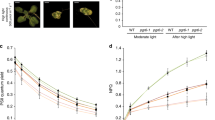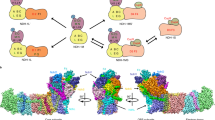Abstract
In photosynthesis, linear electron transport from water to nicotinamide adenine dinucleotide phosphate (NADP+) cannot satisfy the ATP/NADPH production stoichiometry required by the Calvin–Benson cycle. Cyclic electron transport (CET) around photosystem I (PSI) and pseudocyclic electron transport (pseudoCET) can produce ATP without the accumulation of NADPH. Flavodiiron proteins (Flv) are the main mediator of pseudoCET in photosynthetic organisms, spanning cyanobacteria to gymnosperms. However, their genes are not conserved in angiosperms. Here we explore the possibility of complementing CET with Flv-dependent pseudoCET in the angiosperm Arabidopsis thaliana. We introduced FlvA and FlvB genes from the moss Physcomitrella patens into both wild-type (WT) Arabidopsis and the proton gradient regulation 5 (pgr5) mutant, which is defective in the main pathway of CET. We measured rates of pseudoCET using membrane inlet mass spectrometry, along with several photosynthetic parameters. Flv expression significantly increased rates of pseudoCET in the mutant plants, particularly at high light intensities, and partially restored the photosynthetic phenotype. In WT plants, Flv did not compete with PGR5-dependent CET during steady-state photosynthesis, but did form a large electron sink in fluctuating light. We conclude that flavodiiron proteins can help to protect the photosystems in Arabidopsis under fluctuating light, even in the presence of CET.
This is a preview of subscription content, access via your institution
Access options
Subscribe to this journal
Receive 12 digital issues and online access to articles
$119.00 per year
only $9.92 per issue
Buy this article
- Purchase on Springer Link
- Instant access to full article PDF
Prices may be subject to local taxes which are calculated during checkout





Similar content being viewed by others
References
Shikanai, T. Cyclic electron transport around photosystem I: genetic approaches. Annu. Rev. Plant Biol. 58, 199–217 (2007).
Munekage, Y. et al. PGR5 is involved in cyclic electron flow around photosystem I and is essential for photoprotection in Arabidopsis. Cell 110, 361–371 (2002).
Hertle, A. P. et al. PGRL1 is the elusive ferredoxin-plastoquinone reductase in photosynthetic cyclic electron flow. Mol. Cell 49, 511–523 (2013).
Sugimoto, K. et al. A single amino acid alteration in PGR5 confers resistance to antimycin A in cyclic electron transport around PSI. Plant Cell Physiol. 54, 1525–1534 (2013).
Shikanai, T. Chloroplast NDH: a different enzyme with a structure similar to that of respiratory NADH dehydrogenase. Biochim. Biophys. Acta http://dx.doi.org/10.1016/j.bbabio.2015.10.013 (2015).
Peltier, G., Aro, E.-M. & Shikanai, T. NDH-1 and NDH-2 Plastoquinone reductases in oxygenic photosynthesis. Annu. Rev. Plant Biol. http://dx.doi.org/10.1146/annurev-arplant-043014-114752 (2016).
Asada, K. The water-water cycle in chloroplasts: scavenging of active oxygens and dissipation of excess photons. Annu. Rev. Plant Physiol. Plant Mol. Biol. 50, 601–639 (1999).
Badger, M. R., von Caemmerer, S., Ruuska, S. & Nakano, H. Electron flow to oxygen in higher plants and algae: rates and control of direct photoreduction (Mehler reaction) and rubisco oxygenase. Philos. Trans. R. Soc. Lond. B 355, 1433–1446 (2000).
Shirao, M. et al. Gymnosperms have increased capacity for electron leakage to oxygen (Mehler and PTOX reactions) in photosynthesis compared with angiosperms. Plant Cell Physiol. 54, 1152–1163 (2013).
Helman, Y. et al. Genes encoding A-type flavoproteins are essential for photoreduction of O2 in cyanobacteria. Curr. Biol. 13, 230–235 (2003).
Allahverdiyeva, Y. et al. Interplay between flavodiiron proteins and photorespiration in Synechocystis sp. PCC 6803. J. Biol. Chem. 286, 24007–24014 (2011).
Chen, L. et al. Rubredoxin oxidase, a new flavo-hemo-protein, is the site of oxygen reduction to water by the “strict anaerobe” Desulfovibrio gigas. Biochem. Biophys. Res. Commun. 193, 100–105 (1993).
Allahverdiyeva, Y. et al. Flavodiiron proteins Flv1 and Flv3 enable cyanobacterial growth and photosynthesis under fluctuating light. Proc. Natl Acad. Sci. USA 110, 4111–4116 (2013).
Vicente, J. B., Gomes, C. M., Wasserfallen, A. & Teixeira, M. Module fusion in an A-type flavoprotein from the cyanobacterium Synechocystis condenses a multiple-component pathway in a single polypeptide chain. Biochem. Biophys. Res. Commun. 294, 82–87 (2002).
Allahverdiyeva, Y., Isojärvi, J., Zhang, P. & Aro, E.-M. Cyanobacterial oxygenic photosynthesis is protected by flavodiiron proteins. Life 5, 716–743 (2015).
Shikanai, T. Central role of cyclic electron transport around photosystem I in the regulation of photosynthesis. Curr. Opin. Biotechnol. 26, 25–30 (2014).
Müller, P., Li, X. P. & Niyogi, K. K. Non-photochemical quenching: a response to excess light energy. Plant Physiol. 125, 1558–1566 (2001).
DalCorso, G. et al. A complex containing PGRL1 and PGR5 is involved in the switch between linear and cyclic electron flow in Arabidopsis. Cell 132, 273–285 (2008).
Iwai, M. et al. Isolation of the elusive supercomplex that drives cyclic electron flow in photosynthesis. Nature 464, 1210–1213 (2010).
Tagawa, K., Tsujimoto, H. Y. & Arnon, D. I. Role of chloroplast ferredoxin in the energy conversion process of photosynthesis. Proc. Natl Acad. Sci. USA 49, 567–572 (1963).
Konno, H. et al. Thiol modulation of the chloroplast ATP synthase is dependent on the energization of thylakoid membranes. Plant Cell Physiol. 53, 626–634 (2012).
Suorsa, M. et al. PROTON GRADIENT REGULATION5 is essential for proper acclimation of Arabidopsis photosystem I to naturally and artificially fluctuating light conditions. Plant Cell 24, 2934–2948 (2012).
Allahverdiyeva, Y., Suorsa, M., Tikkanen, M. & Aro, E.-M. Photoprotection of photosystems in fluctuating light intensities. J. Exp. Bot. 66, 2427–2436 (2015).
Carraretto, L. et al. A thylakoid-located two-pore K+ channel controls photosynthetic light utilization in plants. Science 342, 114–118 (2013).
Armbruster, U. et al. Ion antiport accelerates photosynthetic acclimation in fluctuating light environments. Nature Commun. 5, 5439 (2014).
Avenson, T. J., Cruz, J. A., Kanazawa, A. & Kramer, D. M. Regulating the proton budget of higher plant photosynthesis. Proc. Natl Acad. Sci. USA 102, 9709–9713 (2005).
Wang, C., Yamamoto, H. & Shikanai, T. Role of cyclic electron transport around photosystem I in regulating proton motive force. Biochim. Biophys. Acta 1847, 931–938 (2015).
Dang, K. V. et al. Combined increases in mitochondrial cooperation and oxygen photoreduction compensate for deficiency in cyclic electron flow in Chlamydomonas reinhardtii. Plant Cell 26, 3036–3050 (2014).
Ruuska, S. A., Badger, M. R., Andrews, T. J. & von Caemmerer, S. Photosynthetic electron sinks in transgenic tobacco with reduced amounts of Rubisco: little evidence for significant Mehler reaction. J. Exp. Bot. 51, 357–368 (2000).
Genty, B., Briantais, J. M. & Baker, N. R. The relationship between quantum yield of photosynthetic electron transport and quenching of chlorophyll fluorescence. Biochim. Biophys. Acta 990, 87–92 (1989).
Acknowledgements
We thank A. Tahara (Kyoto University) and P. Kell (Australian National University) for skilled technical support and A. Makino (Tohoku University), T. Hase (Osaka University), H. Mi (Shanghai Institutes for Biological Sciences, Chinese Academy of Science) for their gifts of antibodies. The information about nucleotide sequences of M. polymorpha Flvs was kindly provided by T. Kohchi (Kyoto University). This work was supported by grants from the Japan Science and Technology Agency (CREST program), the Ministry of Agriculture, Forestry and Fisheries (GPN0008), and the Japanese Society for the Promotion of Science (25251032) and the project Network of Centers of Carbon Dioxide Resource Studies in Plants.
Author information
Authors and Affiliations
Contributions
H.Y. and T.S. designed the research; H.Y. produced transgenic plants; H.Y. and S.T. analysed the plants. All authors designed the experiments, interpreted results and wrote the manuscript.
Corresponding authors
Ethics declarations
Competing interests
The authors declare no competing financial interests.
Supplementary information
Rights and permissions
About this article
Cite this article
Yamamoto, H., Takahashi, S., Badger, M. et al. Artificial remodelling of alternative electron flow by flavodiiron proteins in Arabidopsis. Nature Plants 2, 16012 (2016). https://doi.org/10.1038/nplants.2016.12
Received:
Accepted:
Published:
DOI: https://doi.org/10.1038/nplants.2016.12
This article is cited by
-
Flavodiiron-mediated O2 photoreduction at photosystem I acceptor-side provides photoprotection to conifer thylakoids in early spring
Nature Communications (2023)
-
Adjustment of light-responsive NADP dynamics in chloroplasts by stromal pH
Nature Communications (2023)
-
Revealing the significance of chlorophyll b in the moss Physcomitrium patens by knocking out two functional chlorophyllide a oxygenase
Photosynthesis Research (2023)
-
Roles of ApcD and orange carotenoid protein in photoinduction of electron transport upon dark–light transition in the Synechocystis PCC 6803 mutant deficient in flavodiiron protein Flv1
Photosynthesis Research (2023)
-
Alternative photosynthesis pathways drive the algal CO2-concentrating mechanism
Nature (2022)



